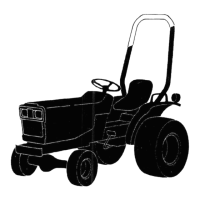
Do you have a question about the Yanmar YM195 and is the answer not in the manual?
Explains safety alert symbols, signal words (DANGER, WARNING, CAUTION), and general safety sign guidance.
Covers safe operation, engine use, slopes, driving hazards, and general precautions for safe tractor operation.
Alerts users to hazards like explosion, fire, high-pressure fluids, and battery safety during operation and service.
Details safety precautions to follow during tractor maintenance and service, including tool usage and modifications.
Provides critical safety instructions for operating the Power Take-Off (PTO) and for transporting the tractor.
Details dimensions, engine, fuel system, capacities, transmission, PTO, hydraulics, electrical, and travel speeds.
Lists dimensions, engine, fuel system, capacities, transmission, PTO, hydraulics, electrical, and travel speeds for these models.
Provides diagrams and a numbered list identifying all major parts and components of the tractor.
Details the function and operation of various tractor controls, including switches, levers, pedals, and indicator lamps.
Outlines essential checks for fuel, oil, coolant, air cleaner, and tires before starting the engine.
Provides step-by-step instructions and safety precautions for starting the tractor engine, including cold weather aids.
Explains engine speeds, hourmeter function, and the correct procedure for safely stopping the engine.
Covers driving the tractor, transmission shifting, front wheel drive, clutch, brakes, and stopping procedures.
Provides guidance on safely operating the tractor on slopes and using the differential lock correctly.
Explains how to monitor engine indicators, listen for abnormal noises, and manage fuel levels during operation.
Covers the operation of the hydraulic lift, position control, and attaching implements to the 3-point hitch.
Details drawbar adjustments, PTO operation, wheel, tire, and tread maintenance procedures.
Explains ballast requirements and provides tire inflation charts for optimal tractor performance and safety.
Covers precautions for driving the tractor on roads and safe procedures for towing the tractor.
Details recommended diesel fuel types, storage guidelines, and filling procedures to ensure engine performance.
Specifies engine oil types, viscosity, transmission-hydraulic oil, grease, and storage of lubricants.
Covers adjustments for clutch, brakes, steering, and correct bolt tightening torques for various tractor components.
Details maintenance for the air intake system (pre-cleaner, air cleaner) and lubricating systems (engine oil, transmission oil).
Guides on maintaining the cooling system (radiator, flushing) and fuel system (strainer, filter, bleeding).
Covers battery, starter, alternator, fuses, and indicator lamps maintenance for the tractor's electrical system.
Provides detailed steps for properly storing the tractor to prevent corrosion and deterioration during extended periods.
Outlines the necessary procedures to safely prepare the tractor for operation after it has been stored.
Addresses common engine problems like hard starting, knocking, irregular running, lack of power, and overheating.
Covers troubleshooting for electrical problems (battery, starter, alternator) and hydraulic system malfunctions.
Helps diagnose issues related to the power train, including clutch slips, transmission noise, and shifting difficulties.
Lists and illustrates various optional equipment available for the tractor, such as weights, lights, and tires.
Provides diagrams and lists of all parts for major tractor systems like the engine, hood, throttle, and front axle.
Lists parts for the transmission, rear axle, hydraulic lift, steering, clutch, brakes, and ROPS.
Details parts for optional equipment like tires, weights, lights, mirrors, thermostat, and steering systems.